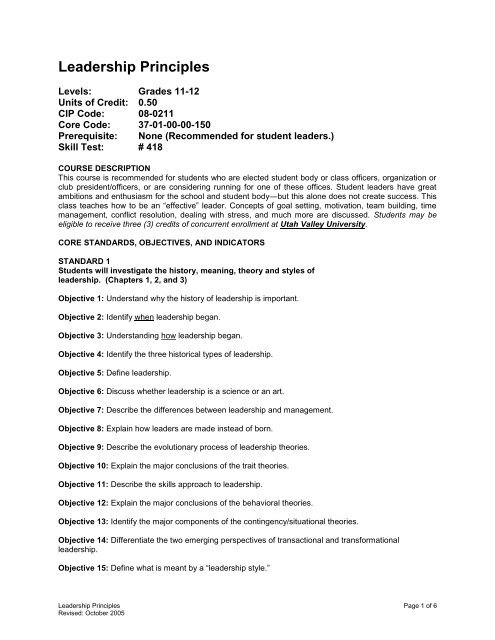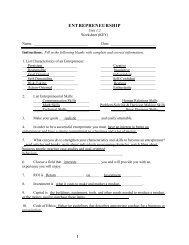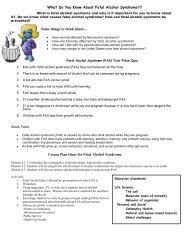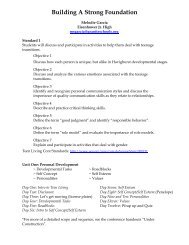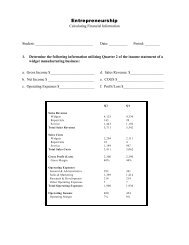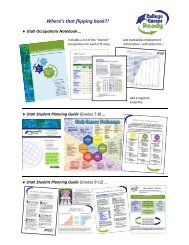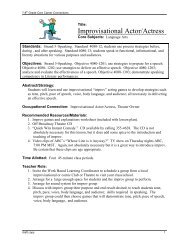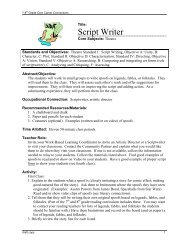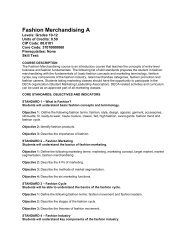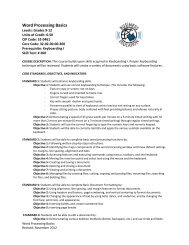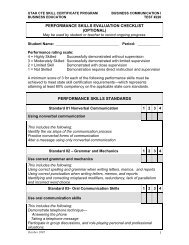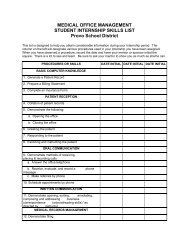Leadership Principles
Leadership Principles
Leadership Principles
You also want an ePaper? Increase the reach of your titles
YUMPU automatically turns print PDFs into web optimized ePapers that Google loves.
<strong>Leadership</strong> <strong>Principles</strong><br />
Levels: Grades 11-12<br />
Units of Credit: 0.50<br />
CIP Code: 08-0211<br />
Core Code: 37-01-00-00-150<br />
Prerequisite: None (Recommended for student leaders.)<br />
Skill Test: # 418<br />
COURSE DESCRIPTION<br />
This course is recommended for students who are elected student body or class officers, organization or<br />
club president/officers, or are considering running for one of these offices. Student leaders have great<br />
ambitions and enthusiasm for the school and student body—but this alone does not create success. This<br />
class teaches how to be an “effective” leader. Concepts of goal setting, motivation, team building, time<br />
management, conflict resolution, dealing with stress, and much more are discussed. Students may be<br />
eligible to receive three (3) credits of concurrent enrollment at Utah Valley University.<br />
CORE STANDARDS, OBJECTIVES, AND INDICATORS<br />
STANDARD 1<br />
Students will investigate the history, meaning, theory and styles of<br />
leadership. (Chapters 1, 2, and 3)<br />
Objective 1: Understand why the history of leadership is important.<br />
Objective 2: Identify when leadership began.<br />
Objective 3: Understanding how leadership began.<br />
Objective 4: Identify the three historical types of leadership.<br />
Objective 5: Define leadership.<br />
Objective 6: Discuss whether leadership is a science or an art.<br />
Objective 7: Describe the differences between leadership and management.<br />
Objective 8: Explain how leaders are made instead of born.<br />
Objective 9: Describe the evolutionary process of leadership theories.<br />
Objective 10: Explain the major conclusions of the trait theories.<br />
Objective 11: Describe the skills approach to leadership.<br />
Objective 12: Explain the major conclusions of the behavioral theories.<br />
Objective 13: Identify the major components of the contingency/situational theories.<br />
Objective 14: Differentiate the two emerging perspectives of transactional and transformational<br />
leadership.<br />
Objective 15: Define what is meant by a “leadership style.”<br />
<strong>Leadership</strong> <strong>Principles</strong> Page 1 of 6<br />
Revised: October 2005
Objective 16: Describe the three classic styles of leadership.<br />
Objective 17: Explain situational leadership.<br />
Objective 18: Explain the difference between Theory X and Theory Y.<br />
Objective 19: Describe how a person develops his/her personal leadership style.<br />
STANDARD 2<br />
Students will learn the importance and fundamentals of a vision and establishing goals.<br />
(Chapters 4 and 5)<br />
Objective 1: Define vision.<br />
Objective 2: Discuss the benefits of a vision.<br />
Objective 3: Explain the steps in creating a vision.<br />
Objective 4: Discuss how the leader communicates the vision.<br />
Objective 5: Explain how a leader sets the example in creating the vision.<br />
Objective 6: Define a goal.<br />
Objective 7: Discuss the three categories of goals.<br />
Objective 8: Describe the basic steps in setting goals.<br />
Objective 9: Explain how the organization obtains goal commitment.<br />
STANDARD 3<br />
Students will understand the importance of time management and time management techniques.<br />
(Chapter 6)<br />
Objective 1: Define time management.<br />
Objective 2: Explain the two governing principles of time management.<br />
Objective 3: Identify several effective time management guidelines.<br />
Objective 4: Describe several meeting management tools for effective leadership.<br />
Objective 5: Discuss why delegation is an important tool for effective time management.<br />
Objective 6: Describe the five step process of delegation.<br />
STANDARD 4<br />
Students will understand effective strategies for communication. (Chapter 7)<br />
Objective 1: What constitutes effective communication?<br />
Objective 2: Understand the five basic levels of communication.<br />
Objective 3: Recognize the value of non-verbal communication.<br />
Objective 4: Identify the three historical types of leadership.<br />
<strong>Leadership</strong> <strong>Principles</strong> Page 2 of 6<br />
Revised: October 2005
Objective 5: What is a “you” message?<br />
Objective 6: Understand an effective “I” message.<br />
Objective 7: Discuss how validation is used.<br />
STANDARD 5<br />
Students will identify and understand the nature of diversity. (Chapter 8)<br />
Objective 1: Discuss how the U.S. image of diversity of changing.<br />
Objective 2: Why should leaders be concerned with diversity?<br />
Objective 3: Identify a subordinate/minority group.<br />
Objective 4: Understand the debate about affirmative action.<br />
Objective 5: Explain how leaders deal with increasing diversity.<br />
STANDARD 6<br />
Students will understand the process for making sound decisions. (Chapter 9)<br />
Objective 1: Define decision making.<br />
Objective 2: Discuss the steps of sound decision making.<br />
Objective 3: Describe the common traps of decision making.<br />
Objective 4: Describe several decision making techniques.<br />
Objective 5: Identify the benefits of group decision making.<br />
STANDARD 7<br />
Students will understand the process for conflict resolution techniques. (Chapter 10)<br />
Objective 1: Define conflict.<br />
Objective 2: Explain the two types of conflict.<br />
Objective 3: Identify the five common causes of conflict.<br />
Objective 4: Describe the five conflict strategies and explain how to use them.<br />
STANDARD 8<br />
Students will identify the sources of power and how they are used. (Chapter 11)<br />
Objective 1: Define power.<br />
Objective 2: Describe and evaluate the five sources of power.<br />
Objective 3: Identify the best sources of power to use.<br />
Objective 4: Explain how power is developed.<br />
Objective 5: Define empowerment and its effectiveness.<br />
<strong>Leadership</strong> <strong>Principles</strong> Page 3 of 6<br />
Revised: October 2005
STANDARD 9<br />
Students will understand the steps to building a successful team. (Chapter 12)<br />
Objective 1: Define a team.<br />
Objective 2: Identify and explain the three types of teams.<br />
Objective 3: What are the advantages of team structures?<br />
Objective 4: What constitutes a high performance team?<br />
Objective 5: What are the stages of team development?<br />
Objective 6: What is teambuilding?<br />
Objective 7: Identify the organizational steps used in building an effective team.<br />
Objective 8: Explain how an individual becomes an effective team member.<br />
STANDARD 10<br />
Students will understand the importance of effectively dealing with change. (Chapter 13)<br />
Objective 1: Explain why changes occur.<br />
Objective 2: Identify the three methods for implementing change.<br />
Objective 3: Discuss how to plan for change.<br />
Objective 4: Identify the reasons why people resist change.<br />
Objective 5: Describe how a leader can facilitate change.<br />
STANDARD 11<br />
Students will understand the importance and application of ethics. (Chapter 14)<br />
Objective 1: Explain morality.<br />
Objective 2: What are ethics?<br />
Objective 3: Discuss the difference between moral problems and ethical dilemmas.<br />
Objective 4: Define social responsibility.<br />
Objective 5: Discuss leaders and ethical behavior.<br />
STANDARD 12<br />
Students will understand the steps to apply basic coaching skills. (Chapter 15)<br />
Objective 1: What is coaching?<br />
Objective 2: How is coaching different from other helping professions?<br />
Objective 3: Discuss two paradigms when coaching.<br />
Objective 4: Discuss a useful coaching model.<br />
Objective 5: Identify an effective model for giving and receiving feedback.<br />
<strong>Leadership</strong> <strong>Principles</strong> Page 4 of 6<br />
Revised: October 2005
Objective 6: Explain why coaching is or is not a universal skill-set.<br />
PERFORMANCE OBJECTIVES<br />
Performance Objective PO-01:<br />
Explain why it is important to understand the history of leadership.<br />
Performance Objective PO-02:<br />
Write the definition of leadership and how leadership is not management.<br />
Performance Objective PO-03:<br />
Describe the evolutionary process of leadership development.<br />
Performance Objective PO-04:<br />
Describe your personal leadership style.<br />
Performance Objective PO-05:<br />
Write down and evaluate a possible vision for an organization.<br />
Performance Objective PO-06:<br />
Identify the key ingredients of goal setting.<br />
Performance Objective PO-07:<br />
Identify the time management skills to increase productivity.<br />
Performance Objective PO-08:<br />
Describe the four styles of communication.<br />
Performance Objective PO-09:<br />
Describe why it is important for leaders to appreciate diversity.<br />
Performance Objective PO-10:<br />
Identify the situational factors affecting individual decision making vs. group decision making.<br />
Performance Objective PO-11:<br />
Identify the five conflict strategies and role play one.<br />
Performance Objective PO-12:<br />
Determine the sources of power and discuss how power is used in organizations.<br />
Performance Objective PO-13:<br />
Demonstrate team-building and identify ways to become an effective team member.<br />
Performance Objective PO-14:<br />
Discuss the course of action an organization would follow to create change.<br />
Performance Objective PO-15:<br />
Explain your commitment to an ethical life.<br />
Performance Objective PO-16:<br />
Describe the GROW model of coaching.<br />
Performance Objective PO-17:<br />
Determine and discuss the skills necessary to becoming a leader.<br />
<strong>Leadership</strong> <strong>Principles</strong> Page 5 of 6<br />
Revised: October 2005
REFERENCE MATERIALS<br />
<strong>Principles</strong> of <strong>Leadership</strong> Teachers Manual and <strong>Principles</strong> of <strong>Leadership</strong> Study Guide<br />
Bitters/Litchford, Utah Valley State College<br />
To obtain a copy, contact Wes Bitters at (801) 863-8234 or e-mail bitterwe@uvsc.edu<br />
Additional Resources:<br />
Utah Valley State College Supplemental Materials (MGMT 1250)<br />
The 7 Habits of Highly Effective People, Stephen R. Covey or The 7 Habits of Highly Effective Teens,<br />
Sean Covey (Time Management)<br />
InsideOut Development, L.L.C. American Fork, Utah (Coaching Skills)<br />
Remember the Titans, video (Effective <strong>Leadership</strong>)<br />
The Hunt for Red October, video (<strong>Leadership</strong> Style)<br />
Hoosiers, video (Team Building)<br />
Gettysburg, video (Vision, Goals)<br />
The Crossing, video (<strong>Leadership</strong> Traits)<br />
<strong>Leadership</strong> <strong>Principles</strong> Page 6 of 6<br />
Revised: October 2005


